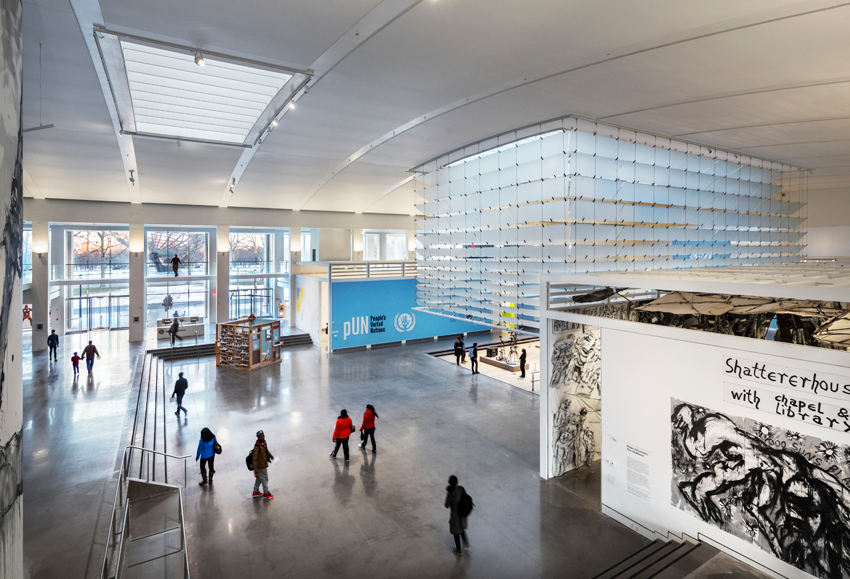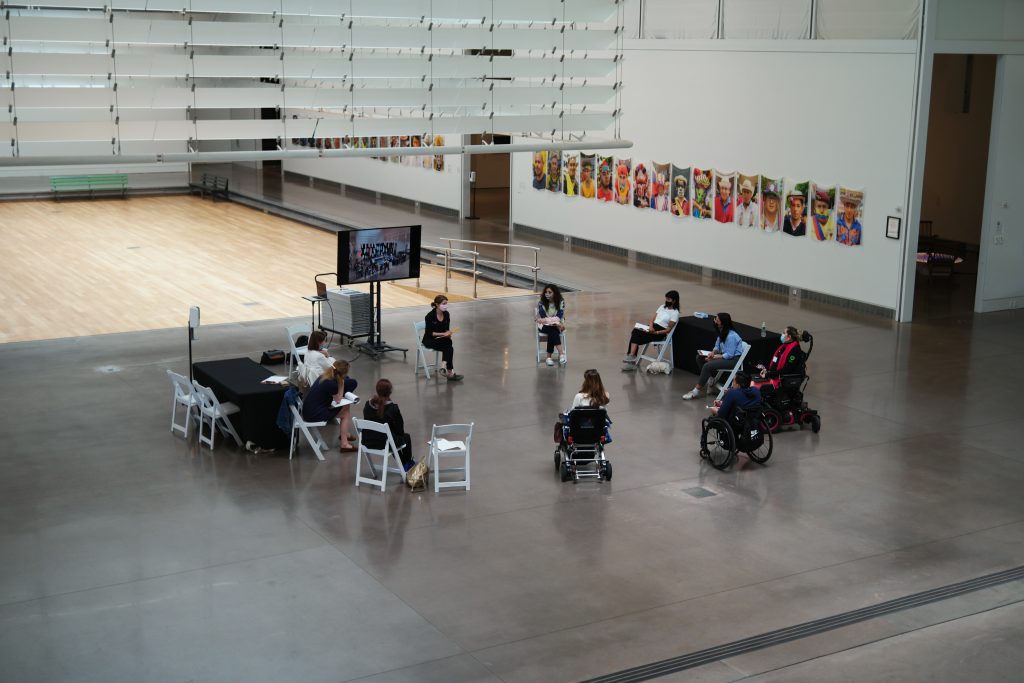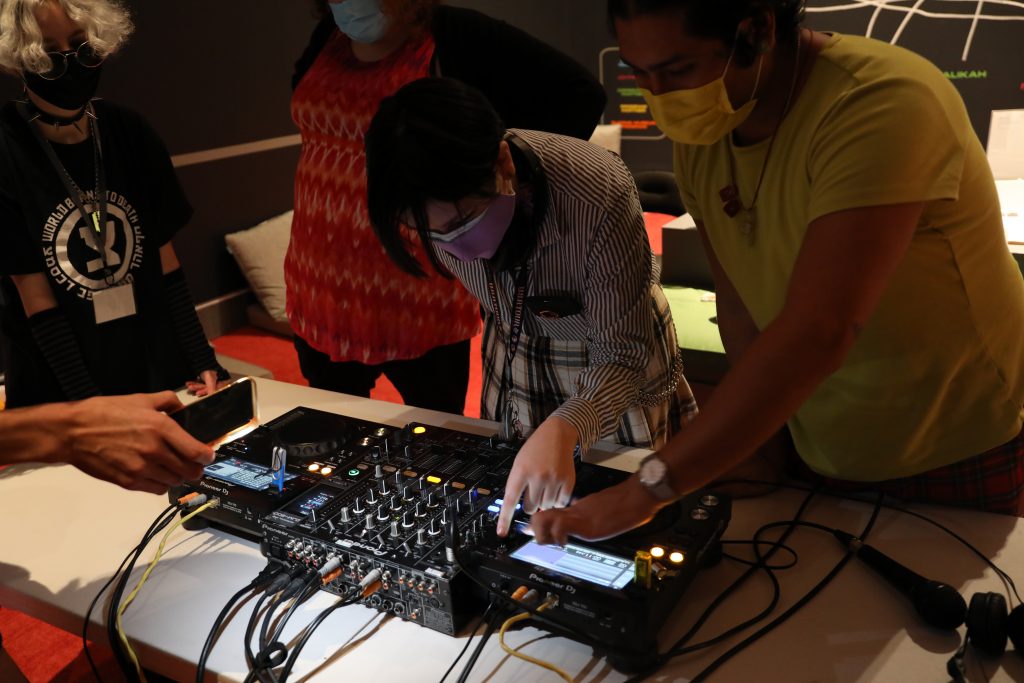Access in the Atrium
A Reflection In-Process
November 2, 2021
Seb Choe, Associate Director of MIXdesign – an inclusive design think tank and YoU Co-Thinker – reflects on the past year working alongside an Access Cohort to imagine new possibilities for the Queens Museum’s Central Atrium.

Image Description: A wide-open, airy, bright, double-height space is sparsely populated with visitors. Four different levels are visible, mediated by staircases and ramps of different heights and slopes. Pops of bright color here and there mark temporary exhibitions, and massive glass louvers known as the “chandelier” are suspended from a skylight, which soaks the space in natural light. A gray, polished concrete floor extends into the distance, where one can see out of floor-to-ceiling window walls onto Flushing Meadows Corona Park, punctuated by a monumental, building-sized steel globe known as the Unisphere.
For the past 14 months, the Queens Museum has been working on “Central Atrium for All,” a project to reimagine the architecture of the Museum building to better serve the needs of all visitors. The project is made possible by a two-year federal grant from the Institute of Museum and Library Services (IMLS). This funding has enabled a partnership between the Queens Museum, MIXdesign, and Queens Community House (a non-profit partner that offers community services and programs). Bringing together these resources and capacities, the aim is to listen to visitors on the margins that hold identities across age, disability, gender, culture, and religion, that are too often faced with access barriers to an equitable visitor experience.
We are currently at the halfway point of this project. To date, we have collected and analyzed 170 visitor surveys, 22 staff questionnaires, hosted four public programs, two professional development trainings, and seven meetings with our Access Cohort — all in order to develop a deeper understanding of how the design of Queens Museum poses accessibility challenges, and what specific design interventions could resolve these barriers. Essential to this mission is the Access Cohort, a group of 25 Queens residents that have agreed to work with us, and contribute the expertise of their lived experience to achieve our goals. The Access Cohort embodies the identities that the Museum wants to further attract to its exhibitions and programs, and includes older adults, wheelchair/scooter/walker users, parents with young children, Native-Spanish speakers, Deaf and hard of hearing folks, people with low-vision, neurodiverse individuals, trans and nonbinary people, and more.

Image Description: Ten individuals wearing face-masks, of varying ages, races, and abilities are seated in a circle, with a large TV monitor on a stand. Three individuals are in wheelchairs and/or motorized scooters. Most people hold clipboards and pens, and look attentively towards one member of the group who is speaking. In the distance, there is a series of colorful banners depicting queer Latinx people, as part of a temporary exhibition.
Recruiting and inviting the Access Cohort to join us in this participatory process has itself been a lesson in access. This work has included negotiating transportation (accessible vans), scheduling (Google Forms), communication (email, Zoom, phone, WhatsApp), dietary restrictions, vaccine mandates, stipend distribution, interpretation (Spanish, ASL), and remote participation. Working through these logistical challenges has generated rich discussion, honest critique, and rewarding moments of creative spatial problem-solving. For example, something as seemingly simple as “accurately capturing participant feedback” becomes a process of 1) recording audio of a Focus Group in a reverberant space with an audience wearing face-masks, 2) transcribing, and sometimes translating, that audio into text, and 3) synthesizing the outcome using best practices in Community-Based Participatory Research, into tables, diagrams, and slideshows that are then used to drive consecutive meetings.

Image Description: One young Latinx woman, one middle-aged Latinx woman, and one older Black Dominican man (all wearing face-masks) gather around a folding table to examine a floor plan of the building. The table features modeling clay, markers, printed-out images of the Queens Museum, and more. The young Latinx woman wears a headset to aid in English-Spanish interpretation.
This process has encouraged us at MIXdesign to resist solutionist instincts commonly found in the discipline of architecture. We’re learning that before jumping to the drafting table, we must move at the speed of trust and relationship-building in order to design a process that invites day-to-day museum visitors as well as museum staff to the brainstorming table. As we move into the next ten months of the project, we plan to keep an open mind, and to generate deliverables that reflect this messy but necessary process. Rather than dictating final universal solutions, we will consider spatial recommendations that are scalable, agile, and practical, to ultimately aid the Queens Museum as it moves from Uncertainty to a reinvigorated mission defined in cooperation with its community.

Image Description: Two young, stylish people wearing face masks, point to the illuminated LED screen of DJ turntables. One wears a lime green t-shirt, and the other wears black and white stripes and a checkered skirt. Two other individuals watch in the background, and a hand holding an iPhone as a flashlight illuminates the DJ equipment.
This project was made possible in part by the Institute of Museum and Library Services.

Related Tags